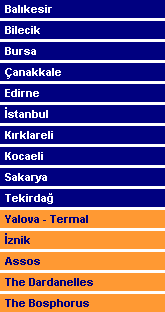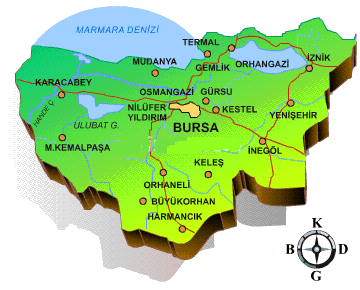| Iznik... |
|
This ancient city may well have been founded around 1000 BC. Antigonos, who was a commander in Alexander the Great’s
army and who had founded the city called "Antigoniea," died in 316 BC whereas the city passed over into the
control of another commander called Lysimachos. Lysimachos developed and beautified the city which he renamed after his
wife Nikaea. Following the death of Lysimachos in 293 BC, the city was taken over by the Bthynians. The Romans took control
of the city in the 2nd century BC and later on it was ruled by the Byzantines. It is known that the first
Christianity Council was held here in the year 325 AD. In 1080, the Seljuk Sultan Kutalmisoglu Süleyman Sah captured the
city and made it the Seljuk capital, but the Byzantines regained the city in 1097. In 1204, the Byzantines fled here during
the Latin plunder of Constantinople whereas it remained their capital for 57 years. Orhan Gazi made the city a part of
Ottoman territory in 1330 whereas the name was changed to its current name of Iznik. The designs found on the walls
surrounding the city, which date from the Roman Period, were an important source of inspiration in the art of Ottoman
ceramics. Traces of some structures that once ornated ancient Iznik can be found today. In the southern part of the city,
one can see remains of a theater that was constructed in the Traian period. A three - columned basilica known as the Iznik
Hagia Sofia can be seen in the middle of the city. The Turks turned it into a mosque and later the famous architect Sinan
had some additional structures built around it. Besides this, there is an obelisk that was formed from five blocks of stone,
a grave chamber constructed in the 4th century BC along with some foundations and marble flooring, which are all
that remains from the 9th century Koimesis. The Haci Özbek Mosque with its single dome represented Iznik’s
Turkish Period masterpieces and was considered to be a pioneering effort in the development of Ottoman mosques. The Yesil
(Green) Mosque, which was built between 1378 - 1391, is regarded as the most important mosque in Iznik in which Çandarli
Halil Pasha commissioned Architect Haci Musa to complete the work. The Nilüfer Hatun Hospice was constructed next to the
Green Mosque in 1388 and was named after the mother of Sultan Murat I, Nilüfer Hatun. Today, it is used as a museum. In
addition, some of Iznik’s historical mosques is the Orhan Gazi Mosque, built in 1334.
|
|

|












